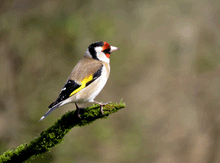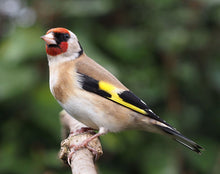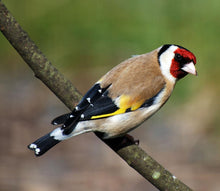The Goldfinch (Carduelis Major (6?)), is a small passerine bird in the finch family.
Distribution: The goldfinch is native to Europe, North Africa, and western and central Asia. It is found in open, partially wooded lowlands and is a resident in the milder west of its range, but migrates from colder regions. It will also make local movements, even in the west, to escape bad weather. It has been introduced to many areas of the world.[6] It was introduced at numerous places in south-eastern Australia in the 19th century, and their populations quickly increased and their range expanded greatly.
Description: The Siberian Goldfinch features a reddish facial feature with a black and white head. On the underside, the Goldfinch is white with various spots on the breast and wings that mix black with yellow. Also, it’s bill is the color of ivory and is on the longer side with a point yet its tail is forked. The male and female feature very similar facial markings, but the red on the female extends only to the eye while the male’s extends passed it. Finally, its song is quick and repetitive.
Song is a pleasant and very characteristic rapid tinkling ‘tsswit-witt-witt’ repeated with various twittering, buzzing ‘zee-zee’ notes added, creating a fast and liquid canary-like song. Call is a shrill or ringing ‘pee-uu’ or ‘tsee-yu’, occasionally followed by a twittering note in flight.
Breeding: Goldfinches nest in the outer twigs of tall leafy trees, or even in bamboo, laying four to six eggs, which hatch in 11–14 days.
Diet: The goldfinch’s preferred food is small seeds such as those from thistles (the Latin name is from Carduus, a genus of thistles) and teasels, but insects are also taken when feeding young. It also regularly visits bird feeders in winter. Diet in captivity: Paradise Earth Premium Finch Blend, Nyjer Seed and greens.






